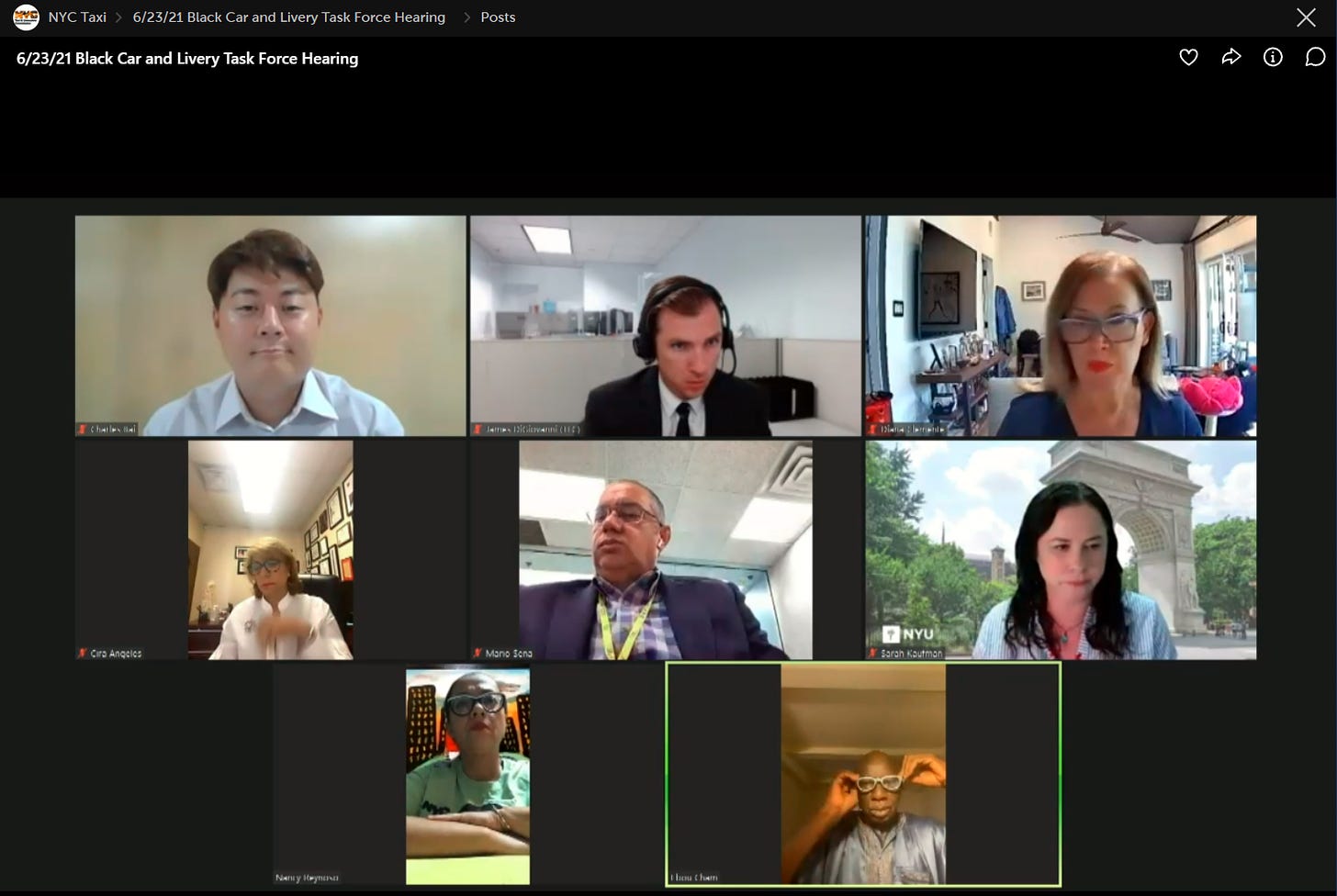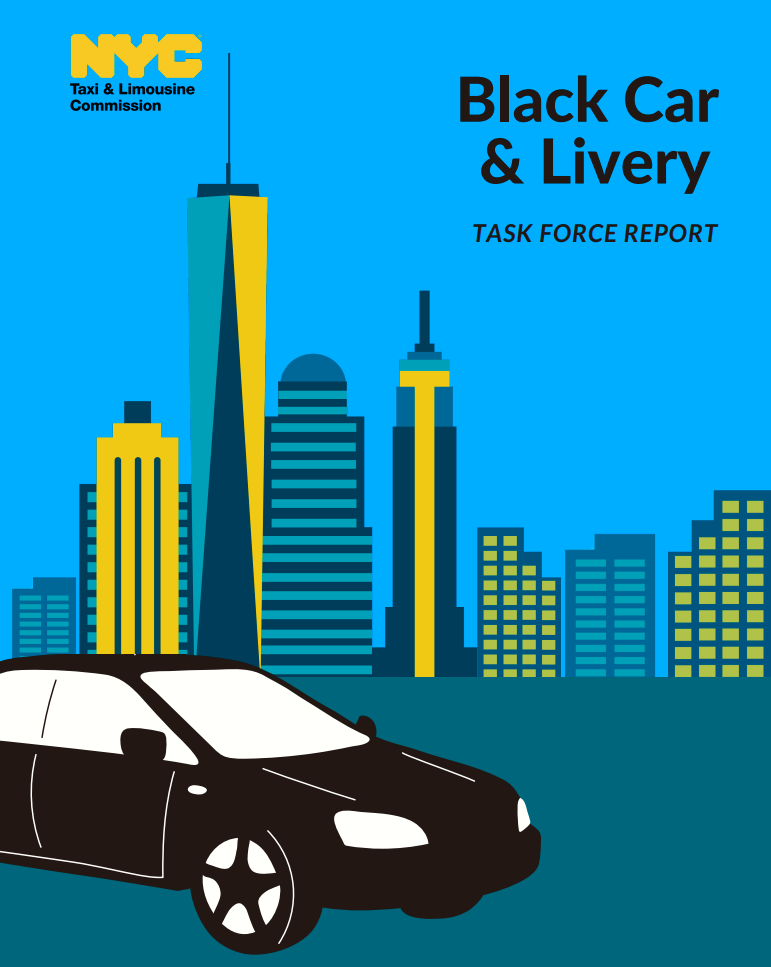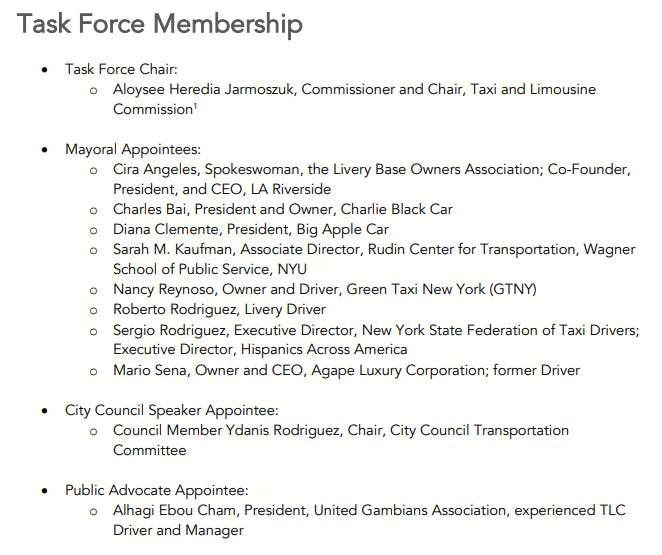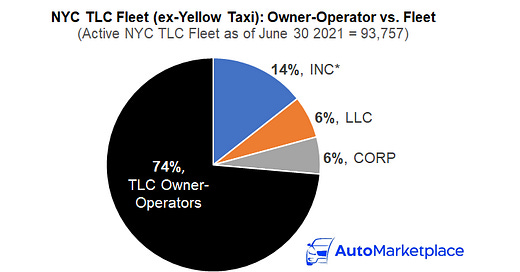

Discover more from AutoMarketplace
Black Car & Livery Task Force Issues Report. From TLC Plate Cap, Advertising, Insurance to Rental Companies, We Summarize Its Findings
After ~6 months of study, research and debate, the Black Car & Livery Task Force issued its recommendations to the NYC Mayor & City Council
AutoMarketplace NYC covers the for-hire transportation industry and automotive news. Check out AutoMarketplace on YouTube ▶️
Almost two years after being sponsored by incoming Department of Transportation (DOT) Commissioner Ydanis Rodriguez, 16 months after being approved by NYC Council and 6 months after officially forming, the Black Car & Livery Task Force has published a report on its findings and recommendations.
The Task Force’s mandate was:

It’s important to note that although rideshare apps like Uber and Lyft have traditionally fallen into the “Black Car” category, the Task Force’s report focused on “traditional” black car & livery bases outside of the apps. Uber and Lyft (and until recently Via) are now often categorized in a separate Black Car category referred to as HVFHS (High Volume For-Hire Services) and increasingly abide by unique rules and regulations.
The full report is 14 pages long (ex-title page and table of contents) and I encourage AutoMarketplace readers to read it (might take 30 minutes). However, for those who may not have the time, we’ve provided a high level summary below that should take 5 to 10 minutes to get through.
Who Was On The Task Force?
The Black Car & Livery Task Force was led by NYC Taxi & Limousine Commission (TLC) Chair Aloysee Heredia Jarmoszuk and included other industry participants (base owners, drivers, academics and others - see below).
What Was The Point?
Although we disclosed the mandate above, in plain English the prime objective of the Task Force was to address how non-Uber and Lyft (aka “traditional”) Black Car & Livery bases could compete more effectively. In addition, the Task Force addressed issues that are common points of curiosity and/or pain for TLC drivers including the FHV License Pause (aka TLC Plate Cap), advertising, insurance costs, interactions with TLC officers and TLC rental costs.
The report shared some interesting data. When most people think about Uber/Lyft’s impact they always point to how the NYC Yellow Cab industry was disrupted. However, traditional bases were as, if not more, impacted by the rise of the ridehailing apps.
What Are The Recommendations?
Task Force recommendations were organized into five categories.
Improving For-Hire Vehicle Licensing Rules and Practices
Modernizing the Black Car and Livery Industries
Refining TLC Enforcement
Ensuring the Continued Critical Role of the Black Car and Livery Sectors in the City’s Transportation Network
Reforming the Regulatory Environment
I will summarize the recommendations that I think most drivers will want to focus on. I also include an index at the end of this article to all the recommendations mentioned in the report that I didn’t highlight below.
TLC Plate Cap Exemption For Traditional Bases
Traditional Black Car & Livery Bases should have a mechanism to license additional vehicles to use exclusively for their base (i.e., no cross base dispatch privileges) to help sustain their businesses. The FHV License Pause (aka TLC Plate Cap) unfairly penalized traditional bases (i.e., didn’t add thousands of cars to the TLC fleet over the last several years).
“While all these proposals deserve a thorough review, I strongly believe that the issuance of a targeted number of new Black Car and Livery licenses is an idea whose time has come. It’s an important way to support an indispensable sector of this industry, while not impacting congestion or the stability of other sectors, and I urge the Commission to move forward with it in the new year.” - Mayor Bill de Blasio
Increase Regulations on TLC Rental Fleets
Given the FHV License Pause (TLC Plate Cap), drivers who don’t own their own car often need to rent from TLC leasing companies who have access to FHV licenses. While these companies can add value and help “reallocate” risks and expenses such as insurance, maintenance and admin costs, they likely need more regulatory oversight, maybe even a separate licensing category, to protect drivers from bad actors.
“The Task Force recommends that TLC explore regulating these leasing companies more directly—in addition to regulating them as FHV license holders—to ensure that these companies better serve drivers. Options that TLC should consider include increasing enforcement for illegal behavior, further regulating the terms of the lease or the lease process, and creating a separate license specifically for these companies. The Task Force also recommends that TLC conduct education and outreach efforts to better inform licensees about TLC’s lease agreement requirements and various leasing terms.”
Prevent Illegal Sale of TLC Plates
Protect drivers from being scammed into purchasing FHV Licenses (TLC Plates) associated with an individual. Such sales are not allowed and are illegal.
“FHV licenses are non-transferable and vehicle owners looking to acquire an FHV license have, historically, applied for a new license directly from TLC. Since the imposition of the FHV license pause, there is concern that FHV licensees have attempted to exploit the unavailability of new FHV licenses by selling or advertising the sale of their FHV licenses at high prices.”
Provide More TLC Insurance Options
Help increase number of companies that offer TLC insurance.
“TLC Drivers have limited options for insuring their vehicles, with only a few insurance companies servicing the for-hire market in New York City. Recent changes to New York State insurance law exacerbated this problem for the Luxury Limousine segment of the FHV industry. High insurance premiums increase the overall costs of operating an FHV, and ultimately reduce take-home pay for drivers. The Task Force recommends that TLC work with stakeholders, private industry, and New York State regulators to explore ways to expand vehicle insurance options for drivers so they may benefit from increased competition among insurers and potentially lower rates.”
No FHV Advertising, But Keep Open Mind
Keep existing ban on exterior and interior advertising on FHVs.
“Local Law 92 required the Task Force to study the feasibility of rooftop and in-car advertising for Black Cars and Livery vehicles. Having discussed this matter, the Task Force finds that benefits to drivers are likely to be minimal, with much of the benefit accruing to the vehicle advertising companies and leasing companies. Additionally, many Task Force members believe that the advertising may be detrimental to their businesses, as drivers and passengers may not want to use a vehicle with interior or exterior advertising and because FHVs are also likely to be the personal vehicles of drivers. The Task Force does acknowledge that new opportunities for increased driver earnings through advertising revenue may arise in the future. Therefore, the Task Force recommends that existing restrictions on interior and exterior FHV advertising remain in place, but TLC should consider revisiting these restrictions in the future as the industry continues to evolve.”
More Relief Stands for all TLC Drivers
Increase parking spaces / stands specifically reserved for TLC drivers.
“Black Car and Livery drivers have reported a lack of places to park their vehicles in order to take a break, particularly places with access to restrooms and running water, as restroom access at the bases themselves has proven insufficient or is inconvenient for drivers during their workday. The Task Force recommends that the City consider increasing the number of Taxi/FHV relief stands and continue to convert Taxi-only relief stands to Taxi/FHV relief stands where appropriate. Drivers have also reported that some FHV bases do not always allow them to use the bases’ restrooms. The Task Force recommends that TLC conduct further fact-finding on this issue and evaluate ways to ensure driver access to restrooms at their affiliated and dispatching bases.”
Promote Better Relations Between TLC & Drivers
Encourage better relations between TLC drivers and TLC enforcement officers.
“Interactions between TLC-licensed Drivers and TLC enforcement officers can be tense for both parties. Some TLC Drivers report negative experiences with TLC officers, and the Task Force recognizes that TLC officers have a difficult and often dangerous job. The Task Force recommends that TLC develop opportunities for outreach and engagement between TLC enforcement officers and TLC-licensed Drivers, particularly in the Black Car and Livery sectors, with the goal of increasing mutual understanding. The Task Force also recommends that TLC enhance its customer-focused trainings for enforcement officers to improve interactions with licensees.”
Consider Impacts of Additional Congestion Fees
Consider impact of adding additional congestion-related fees to NYC for-hire trips (Note: we covered this topic yesterday).
“FHV passengers, including SHL passengers, currently pay a $2.75 congestion surcharge for all trips that start, pass through, or end in Manhattan below 96th Street, except for shared rides, which are charged $0.75. The MTA is implementing an additional congestion pricing program for all trips below 60th Street in Manhattan, a process that is currently in the review period. In September of 2021, the MTA estimated that this new fee could range from $9 to $35 depending on time of day, method of payment, and other factors.20 The MTA has not stated whether this charge will be applied to trips by TLC-licensed vehicles, including Black Car and Livery trips, on top of the existing congestion surcharge. The Task Force recommends that the MTA carefully consider the impacts that any additional fees would have on the Black Car, Livery, and SHL industries and recognize appropriate differences among various segments of the FHV industry.”
Other Recommendations Not Mentioned
To read more about the below recommendations (i.e., not highlighted above) please refer to the full report. If there are recommendations above or below you would like me to cover in more detail, please reach out at info@automarketplace.com.
1. Improving For-Hire Vehicle Licensing Rules and Practices
Recommendation 1.3. Update license forfeiture practices after failed vehicle inspections.
Recommendation 1.4. Explore the creation of new revenue streams to incentivize adding wheelchair accessible vehicles to the Black Car and Livery fleets.
Recommendation 1.5. Consider ways to improve financing mechanisms to help drivers afford new vehicle purchases.
2. Modernizing the Black Car and Livery Industries
Recommendation 2.1. Explore prepayment options and non-cash payments for FHV trips.
Recommendation 2.2. Improve data collection standards for FHV trips.
Recommendation 2.3. Adopt an electric vehicle plan to increase their use as FHVs.
3. Refining TLC Enforcement
Recommendation 3.1. Focus on curtailing illegal street hail activity.
Recommendation 3.3. Protect licensees from intermediaries
4. Ensuring the Continued Critical Role of the Black Car and Livery Sectors in the City’s Transportation Network
Recommendation 4.1. Expand pick-up and drop-off zones and Taxi/FHV stands
5. Reforming the Regulatory Environment
Recommendation 5.2. Explore changes to the Livery Fund and Black Car Fund.
Recommendation 5.4. Streamline and modernize TLC rules where appropriate to make compliance less burdensome and oversight more effective.
For the full Black Car & Livery Task Force Report click here
AutoMarketplace NYC covers the for-hire transportation industry and automotive news. Check out AutoMarketplace on YouTube ▶️















